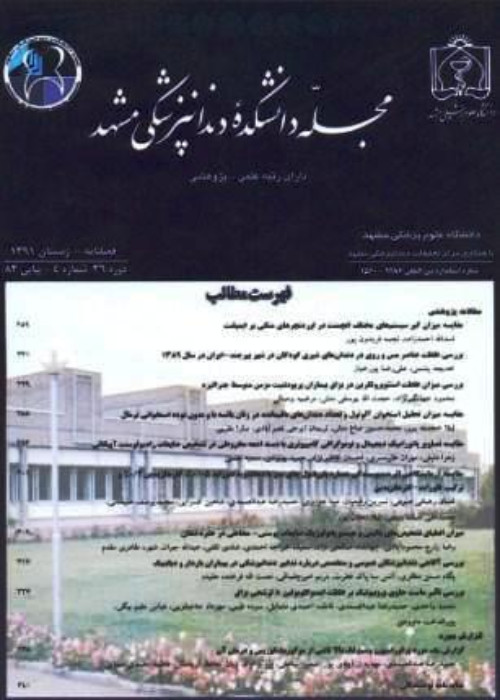Effect of Repeated Porcelain Firings on Corrosion Resistance and Surface Properties of Base Metal Alloys
Author(s):
Article Type:
Research/Original Article (دارای رتبه معتبر)
Abstract:
Introduction
Regarding the use of nickel-chromium (Ni-Cr) alloy in porcelain-fused to metal-restorations and the need for high temperature for porcelain firing, there are probable alterations in the microstructure of the alloy, the corrosion resistance, and the rate of ion release. The aim of the present study was to evaluate the effect of multiple firings on the corrosion resistance and surface characteristics of two Ni-Cr alloys. Materials and Methods
In total, 24 discs were made from each Ni-Cr alloys without beryllium (Dam Cast) and with beryllium (Super Cast). They were then assigned into four subgroups based on the number of firings: (1) without firing, (2) four times firing, (3) four times firing and a correctional firing, and (4) four times firing and two correctional firings. The corrosion resistance was evaluated using an electrochemical potentiostat device. The ions release was measured after immersing samples in Fusayama artificial saliva (pH of 5, at 37 ◦c) for 30 days by ICP-AES technique. The surface of the alloys was evaluated with a metallurgical light microscope and scanning electron microscope. Data were analyzed in SPSS software .P-value less than 0.05 was considered statistically significant. Results
According to the results, the impedance of both alloys decreased significantly with increasing the frequency of firings. A significant decrease was observed in the impedance and corrosion resistance of Super Cast alloy using correctional firings (the third and fourth firings), compared to Porcelain firing samples. However, no significant decrease was observed in Dam Cast. In addition, the number of released ions was significantly increased with an increase in the number of firings in both alloys. Nevertheless, there was no difference between the alloys regarding the released ions. The concentration of released ions was higher in Super Cast alloy, compared to that in DAM Cast. Increased levels of corrosion were observed on the surface of Super Cast alloys using a microscopic evaluation. Conclusion
Multiple firings had lower effects on the corrosion resistance of Dam Cast alloy without beryllium, compared to Super Cast alloy with beryllium.Keywords:
Language:
Persian
Published:
Journal of Mashhad Dental School, Volume:43 Issue: 3, 2019
Pages:
227 to 241
magiran.com/p2022159
دانلود و مطالعه متن این مقاله با یکی از روشهای زیر امکان پذیر است:
اشتراک شخصی
با عضویت و پرداخت آنلاین حق اشتراک یکساله به مبلغ 1,390,000ريال میتوانید 70 عنوان مطلب دانلود کنید!
اشتراک سازمانی
به کتابخانه دانشگاه یا محل کار خود پیشنهاد کنید تا اشتراک سازمانی این پایگاه را برای دسترسی نامحدود همه کاربران به متن مطالب تهیه نمایند!
توجه!
- حق عضویت دریافتی صرف حمایت از نشریات عضو و نگهداری، تکمیل و توسعه مگیران میشود.
- پرداخت حق اشتراک و دانلود مقالات اجازه بازنشر آن در سایر رسانههای چاپی و دیجیتال را به کاربر نمیدهد.
In order to view content subscription is required
Personal subscription
Subscribe magiran.com for 70 € euros via PayPal and download 70 articles during a year.
Organization subscription
Please contact us to subscribe your university or library for unlimited access!


